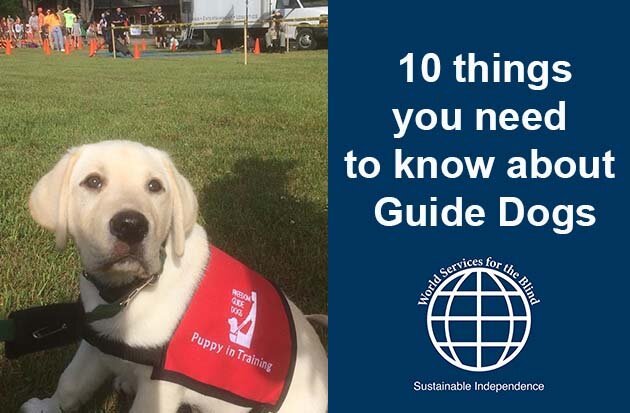10 Things You Should Know About Guide Dogs | Guide Dog Awareness Month
/guide dog puppy in training with red vest with white text “10 things you need to know about Guide Dogs” with WSB logo underneath, a globe image with World Services for the Blind wrapped around
10 things you should know about Guide Dogs
September is Guide Dog Awareness Month. With that, we wanted to share 10 things you should know about guide dogs whether you are thinking of getting one or just interested in these amazing animals!
1. History of Guide Dogs
Service dogs go all the way back to the 16th century! The first guide dog training school was created in Germany to assist veterans returning from WW1. In 1929, the first Guide Dog school in the United States, the Seeing Eye, was established. Since then, there are so many different guide dog schools across the world!
2. There are many different Guide Dog Schools
As mentioned in #1, there are so many different schools to choose from! Every school has different training philosophies so choosing a school can depend on what kind of training systems you are looking for. Schools can also differ in ownerships of the dog or even vet bills. There are Guide Dog schools all over the country from Leader Dogs in Michigan to Guide Dogs of America in California! You are sure to find one in the location you are looking for. There are even some schools that will bring the training to you!
3. Do not pet a dog in harness
Perhaps the most important thing to know about guide dogs is to not pet them while they are in harness! Guide dogs are providing an invaluable service to their handlers by being their eyes! Guide dogs are trained to ignore distractions, but that means if you see someone with a guide dog you should not pet them while in harness.
three dogs sitting looking at the camera. dog on the left is a pet and chocolate color. the dogs to the right are guide dogs, one a black lab and one a yellow lab.
4. Guide dogs are just dogs after all
When a dog is not working however; that is a different story! When off harness, guide dogs are just like regular dogs. They love to play, run around, and get attention from people!
5. Guide dogs are not a GPS!
A common misconception is that guide dogs are like GPS’s and they know when to cross the street. This is not true. Guide dogs are trained to guide so that their handlers miss obstacles, stay in a straight line, or navigate crowds. The handler decides when to cross a street and which direction to go. But there is something called Safety Disobedience that we discussed in our blog post if a guide dog is right for you! Safety Disobedience allows the dog to decide if it is not safe to cross a street and will disobey the handlers commands.
6. They can go (almost) anywhere in the United States
With some very few exceptions, like a zoo, guide dogs are allowed in every public area! Thanks to the ADA, guide dogs are able to go to any establishment including restaurants, stores, public transportation, ride share services, airplanes, and anywhere a handler may go.
7. Emotional Support Animals are very different
Guide dogs go through years of training and cost over $40,000 to train. Guide Dogs begin training as young puppies and are given to handlers when they are around two years old. While on the other hand, emotional support animals are not certified and oftentimes, do not have any training.
8. Guide dogs are matched specifically with their handler
This goes back to the point about the extensive amount of training a guide dog receives, they are also matched specifically with their handler based on their lifestyle and their walking speed/gate.
9. Most common Breeds
The most common guide dog Breeds are labs, golden retrievers, and German Shepherds. Some schools also train standard poodles if a handler is allergic!
10. Bring a sense of independence
Guide dogs bring a tremendous level of independence for their handlers. There are so many reasons one may get a guide dog but one reason we hear over again is the sense of independence a dog brings to the blind individual.
(Photos Courtesy of Sharon Giovinazzo, CEO & President)



